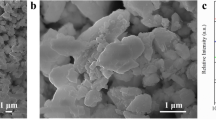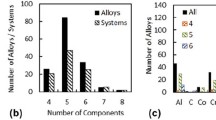Abstract
Co–Re-base alloys with very high melting point are being developed to supplement Ni-superalloys in future gas turbines in which much higher gas entry temperatures are expected. The microstructure of Co–17Re–23Cr–2.6C and Co–17Re–23Cr–1.2Ta–2.6C alloys has been investigated by scanning and transmission electron microscopy. These alloys are mainly strengthened by carbides of Cr and/or Ta, but it is not trivial to accurately quantify the composition of the carbides. The compositions of the various carbides in Co–Re–base alloys were quantified with near-atomic resolution using atom probe tomography. The Cr as well as Ta carbides exists in the alloys with different morphologies, ranging from extremely fine (nm scale) to large (μm scale) sizes. The composition and the crystal structure of the investigated phases were measured and reported. It is shown that both types of carbides are stable up to 1000 °C but the Ta carbides are more stable than the Cr carbides at 1200 °C after long-time ageing. They are also effective as strengthening precipitates.






Similar content being viewed by others
Notes
All compositions in this paper are given in atomic percentage.
References
Sullivan PC, Donachie MJ and Morral FR (1970) Cobalt-base superalloy-1970. Cobalt Monograph Series Cobalt Information Center, Brussels
Sato J, Omori T, Oikawa K, Ohnuma I, Kainuma R, Ishida K (2006) Cobalt-base high-temperature alloys. Science 312:90–91
Rösler J, Mukherji D, Baranski T (2007) Co–Re-based alloys: a new class of high temperature materials? Adv Eng Mater 9:876–881
Mukherji D, Gilles R, Karge L, Strunz P, Beran P, Eckerlebe H, Stark A, Szentmiklosi L, Mácsik Z, Schumacher G, Zizak I, Hofmann M, Hoelzel M, Rösler J (2014) Neutron and synchrotron probes in the development of Co–Re-based alloys for next generation gas turbines with an emphasis on the influence of boron additives. J Appl Cryst 47:1417–1430
Brunner M, Hüttner R, Bölitz M-C, Völkl R, Mukherji D, Rösler J, Depka T, Somsen C, Eggeler G, Glatzel U (2010) Creep properties beyond 1100°C and microstructure of Co–Re–Cr alloys. Mat Sci Eng A 528:650–656
Mukherji D, Klauke M, Strunz P, Zizak I, Schumacher G, Wiedenmann A, Rösler J (2010) High temperature stability of Cr carbides in an experimental Co–Re-based alloy. Int J Mat Res 101:340–348
Mukherji D, Strunz P, Gilles R, Hofmann M, Schmitz F, Rösler J (2010) Investigation of phase transformations by in situ neutron diffraction in a Co–Re-based high temperature alloy. J Mater Lett 64:2608–2611
Mukherji D, Strunz P, Piegert S, Gilles R, Hofmann M, Hoelzel M, Rösler J (2012) The hexagonal close-packed (HCP) ⇆ face-centered cubic (FCC) transition in Co–Re-based experimental alloys investigated by neutron scattering. Metall Mater Trans A 43:1834–1844
Mukherji D, Rösler J, Wehrs J, Strunz P, Beran P, Gilles R, Hofmann M, Hoelzel M, Eckerlebe H, Szentmiklósi L, Mácsik Z (2013) Application of in situ neutron and X-ray measurements at high temperatures in the development of Co–Re-based alloys for gas turbines. Metall Mater Trans A 44:22–30
Blavette D, Deconihout B, Bostel A, Sarrau JM, Bouet M, Menand A (1993) The tomographic atom-probe: a quantitative three-dimensional nanoanalytical instrument on a nearly atomic-scale. Rev Sci Instrum 64:2911–2919
Kelly TF, Larson DJ (2012) Atom probe tomography 2012. Annu Rev Mater Res 42:1–31
Timochina IB, Hodson PD, Ringer SP, Zheng RK, Pereloma EV (2007) Precipitate characterization of an advanced high-strength low-alloy (HSLA) steel using atom probe tomography. Scr Mater 56:601–604
Mulholland MD, Seidman DN (2011) Nanoscale co-precipitation and mechanical properties of a high-strength low-carbon steel. Acta Mater 59:1881–1897
Seol J-B, Raabe D, Choi P, Park HS, Kwak JH, Park CG (2013) Direct evidence for the formation of ordered carbides in a ferrite-based low-density Fe–Mn–Al–C alloy studied by transmission electron microscopy and atom probe tomography. Scr Mater 68:348–353
Thuvander M, Weidow J, Angseryd J, Falk LKL, Sonestedt M, Stiller K, Andren H-O (2011) Quantitative atom probe analysis of carbides. Ultramicroscopy 111:604–608
Marceau RKW, Choi P, Raabe D (2013) Understanding the detection of carbon in austenitic high-Mn steel using atom probe tomography. Ultramicroscopy 132:239–247
Yuan L, Ponge D, Wittig J, Choi P, Jimenez JA, Raabe D (2012) Nanoscale austenite reversion through partitioning, segregation and kinetic freezing: example of a ductile 2 GPa Fe–Cr–C steel. Acta Mater 60:2790–2804
Wanderka N, Wahi RP (1994) An AP/FIM and TEM study of the microstructural evolution of MANET steel after dual-beam irradiation. Appl Surf Sci 76(77):272–277
Delargy KM, Smith GDW (1983) Phase composition and phase stability of a high-chromium nickel-based superalloy, IN939. Metall Mater Trans A 14:1771–1783
Blavette D, Duval P, Letellier L, Guttmann M (1996) Atomic-scale APFIM and TEM investigation of grain boundary microchemistry in Astroloy nickel base superalloys. Acta Mater 44:4995–5005
Gusev AI, Rempel AA, Magerl AJ (2001) Disorder and order in strongly nonstoichiometric compounds: transition metal carbides nitrides and oxides. Springer Verlag, Berlin
Blavette D, Vurpilott F, Pareige P, Menand A (2001) A model accounting for spatial overlap in 3D atom-probe microscopy. Ultramicroscopy 89:145–153
Yao L, Withrow T, Restrepo OD, Windl W, Marquis EA (2015) Effect of the local structure dependence of evaporation fields on field evaporation behavior. Appl Phys Lett 107:241602
Hättestrand M, Andrén H-O (1999) Boron distribution in 9–12 % chromium steels. Mat Sci & Eng A 270:33–37
Hofer P, Miller MK, Babu SS, David SA, Cerjak H (2000) Atom probe field ion microscopy investigation of boron containing martensitic 9 % chromium steel. Metall Mater Trans A 31:975–984
Paulisch M, Wanderka N, Miehe G, Mukherji D, Rösler J, Banhart J (2013) Characterization of borides in Co–Re–Cr-based high-temperature alloys. J Alloys Compd 569:82–87
Acknowledgements
The authors would like to thank the German Research Foundation (DFG) for providing the financial support under the Contract Number RO 2045/31-1 at the TU Braunschweig. One of the authors would like to thank the Alexander von Humboldt Foundation for financial support to do research at the HZB.
Author information
Authors and Affiliations
Corresponding author
Rights and permissions
About this article
Cite this article
Wanderka, N., Mousa, M.S., Henke, P. et al. Carbides in Co–Re–Cr-based high-temperature alloys. J Mater Sci 51, 7145–7155 (2016). https://doi.org/10.1007/s10853-016-9995-3
Received:
Accepted:
Published:
Issue Date:
DOI: https://doi.org/10.1007/s10853-016-9995-3




